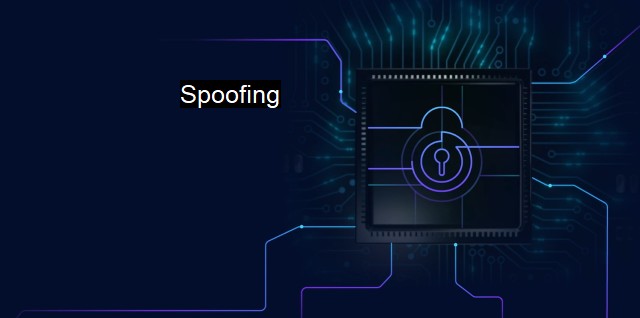What is Spoofing?
Understanding Spoofing and Its Various Types: Detection, Prevention, and the Role of Antivirus Software in Cybersecurity
Spoofing is a critical threat in the realm of cybersecurity. "Spoofing" pertains to the malicious practice where communication from an unknown source is disguised to appear as if it originates from a known, trusted source. This method is widely exploited by harmful actors in the cyber world to trick unsuspecting internet users into giving away confidential information, performing actions that compromise their data, or infecting their computers with malicious software.The term "spoofing" is often applied in the context of IP spoofing, Email spoofing and Caller ID spoofing, each serving slightly different, but equally malign purposes. The core concept remains the same - the culprit seeks to gain unauthorized access, to deceive, manipulate, and lure victims into a trap.
In IP spoofing, cyber actors manipulate packet headers to conceal their identity across a network. an attacker modifies the source IP address in the outgoing packet header to hide the real source, potentially impersonating another user or system in the network. Through this method, the attacker masquerades behind the identity of a legitimate user or device, tricking the network into believing that the traffic is from a trusted source. IP spoofing forms the backbone of numerous network attacks, including Zero-Day attacks and man-in-the-middle attacks.
Email spoofing revolves around the deceptive practice of sending emails with a forged sender address. This is often exploited in phishing attacks, where an attacker alters the email header so that it appears to come from a different address, generally one that the recipient recognizes and trusts. These deceptive emails often lure individuals to divulge sensitive material such as financial details or login credentials, facilitate the download of malware, or incite harmful actions.
Caller ID Spoofing, meanwhile, is commonly employed in voice phishing, or ‘vishing,’ attacks. Here, scammers use advanced voice technologies to alter the caller ID, posing as banking institutions or other services familiar to the receiver to trick them into disclosing personal information.
Spoofing represents a significant cybersecurity concern, making it absolutely critical for individuals and organizations to have protective measures like antiviruses and firewalls in place. Antivirus software is critical in defending against such cyber threats. While traditional antivirus software predominantly uses static analysis, including scanning for known threats and malware patterns, evolving and sophisticated spoofing attacks necessitate more sophisticated antivirus techniques, which include dynamic analysis, or evaluating ‘behavior’ to identify new and unknown threats.
Stronger methods to authenticate communication offer better protection against spoofing. Techniques such as cryptographic network protocols, including transport layer security and secure shell, can render IP spoofing significantly more difficult. Installing updated antivirus software and keeping systems patched against known vulnerabilities is a potential weapon to ward off email spoofing. Regularly updating web application firewalls can also protect against such threats.
Specifically against email spoofing, protocols like DMARC, SPF, and DKIM quarantine or reject emails that fail authentication tests. deep learning algorithms and artificially intelligent antivirus software bolster an organization's defense capabilities against spoofing, scanning emails and networks for anomalous traffic patterns and inspecting source IPs to isolate and deal with potential threats.
As cyber threats become sophisticated, managing cybersecurity is an evolving saga. Understanding spoofing attacks, familiarizing oneself with its main types and their traits significantly contribute to prevent falling prey to these attacks. A combination of raising awareness, implementing technological safeguards like operational security controls, continuous monitoring, and proactive defenses forms the cornerstone of a comprehensive anti-spoofing strategy. It is essential to remain vigilant, stay updated, and fortified with the right tools and strategies to defend against this subtle yet powerful cyber threat.

Spoofing FAQs
What is spoofing in cybersecurity?
Spoofing is a technique used by cybercriminals to conceal their identity or mimic a trusted entity through the manipulation of data packets, email headers, or caller ID. It's a common tactic used in phishing attacks and other online scams.How does email spoofing work?
Email spoofing involves altering the sender's name or email address in the header of an email. This makes it appear as if the email was sent from a different person or organization. Cybercriminals use this technique to trick recipients into opening the email and clicking on malicious links or attachments.What are some ways to detect and prevent spoofing attacks?
Some ways to detect and prevent spoofing attacks include implementing email authentication protocols like SPF, DKIM, and DMARC, using anti-spam and anti-malware filters, and educating employees about the risks of clicking on suspicious emails or links. It's also important to keep software and security patches up to date to prevent vulnerabilities that can be exploited by hackers.How can antivirus software help protect against spoofing?
Antivirus software can help protect against spoofing by detecting and blocking malicious emails or websites that may be used in spoofing attacks. Some antivirus programs also offer features like email scanning and anti-phishing protection to help prevent users from falling for spoofed emails. However, antivirus software should not be the only line of defense against spoofing attacks, and other security measures should also be implemented.| | A | | | B | | | C | | | D | | | E | | | F | | | G | | | H | | | I | | | J | | | K | | | L | | | M | |
| | N | | | O | | | P | | | Q | | | R | | | S | | | T | | | U | | | V | | | W | | | X | | | Y | | | Z | |
| | 1 | | | 2 | | | 3 | | | 4 | | | 7 | | | 8 | | |||||||